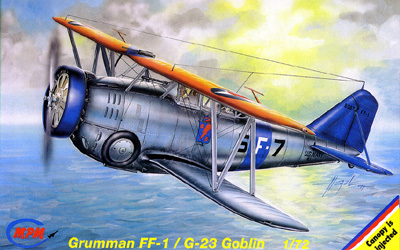
MPM 1/72 Grumman FF-1 G-23 Goblin
By Chris Banyai-Riepl
Overview
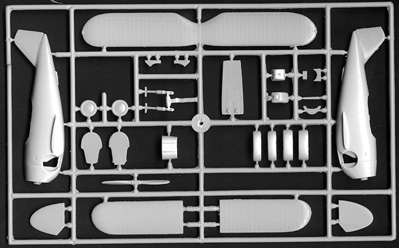 The line of Grumman biplane fighters is a long one, and they have always been a colorful bunch. MPM has come out with the two-seat FF-1 fighter, which was the first of this great lineage. While most people will want this one for the great US Navy color schemes possible, this plane saw service with Canada, Spain and Nicaragua, so there are plenty of interesting choices out there.
The line of Grumman biplane fighters is a long one, and they have always been a colorful bunch. MPM has come out with the two-seat FF-1 fighter, which was the first of this great lineage. While most people will want this one for the great US Navy color schemes possible, this plane saw service with Canada, Spain and Nicaragua, so there are plenty of interesting choices out there.
This kit is a multimedia kit, with resin, photoetch and injection parts. This kit also introduces MPM's first attempts at injection molded clear parts, and it's not that bad. While not up to par with such companies as Hasegawa or Monogram, it is definitely usable, and is less work than the vacuform ones in previous kits.
The Kit
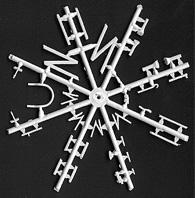 The injection parts are on two trees, and exhibit some very fine molding throughout. There is little flash, and all the panel lines are finely recessed. The wing ribs are well presented, with no fabric texture present and just a hint of the rib, which, with a coat of paint, will look very good. The wing struts are nicely done and are in an airfoil shape. The lack of locating holes will make placement of these struts something of a challenge, but it also eliminates those difficult seams caused by too large mounting pegs. There are separate parts for the G-23 variant which involves cutting a section out of the fuselage and replacing it with another piece. This might turn some off on doing these other variants, but it really doesn't look like it would be much work.
The injection parts are on two trees, and exhibit some very fine molding throughout. There is little flash, and all the panel lines are finely recessed. The wing ribs are well presented, with no fabric texture present and just a hint of the rib, which, with a coat of paint, will look very good. The wing struts are nicely done and are in an airfoil shape. The lack of locating holes will make placement of these struts something of a challenge, but it also eliminates those difficult seams caused by too large mounting pegs. There are separate parts for the G-23 variant which involves cutting a section out of the fuselage and replacing it with another piece. This might turn some off on doing these other variants, but it really doesn't look like it would be much work.
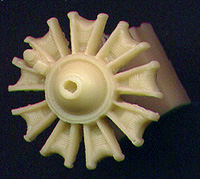 The engine is a nicely done resin job, and captures the look of the Wright Cyclone that powers the FF-1. Two choices of cowls wrap around this engine, again as a result of the different variants depicted on the decal sheet.
The engine is a nicely done resin job, and captures the look of the Wright Cyclone that powers the FF-1. Two choices of cowls wrap around this engine, again as a result of the different variants depicted on the decal sheet.
The photoetch brass provides a very detailed interior, with a nice relief etched panel, sidewall consoles, and seat belts. Other parts include the wheel box and some mass balances.
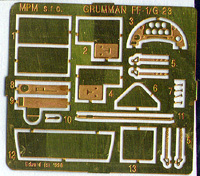 The decal sheet provides choices for no less than four FF-1/G-23s, including one US Navy, one RCAF, and two Spanish ones. The decals are printed by Propagteam and are thin and perfectly registered. There is an error on the sheet, though, in which the serial number for one of the Spanish ones has a nine instead of a three. This is pointed out in the instructions along with a method for fixing it, which is to be commended. This attention to detail and a ready willingness to admit when they have made a mistake is very welcome, and I hope that other manufacturers follow suit. The US Navy version offers two styles of unit badge for VF-5B, letting the modeler decide which way it faces, another nice touch. The Canadian version is a G-23 Goblin of No. 118(F) Sqn, 1941, and the two Spanish examples are from 1a Escuadrillaand 2a Escuadrilla, Spanish Republican Air Force.
The decal sheet provides choices for no less than four FF-1/G-23s, including one US Navy, one RCAF, and two Spanish ones. The decals are printed by Propagteam and are thin and perfectly registered. There is an error on the sheet, though, in which the serial number for one of the Spanish ones has a nine instead of a three. This is pointed out in the instructions along with a method for fixing it, which is to be commended. This attention to detail and a ready willingness to admit when they have made a mistake is very welcome, and I hope that other manufacturers follow suit. The US Navy version offers two styles of unit badge for VF-5B, letting the modeler decide which way it faces, another nice touch. The Canadian version is a G-23 Goblin of No. 118(F) Sqn, 1941, and the two Spanish examples are from 1a Escuadrillaand 2a Escuadrilla, Spanish Republican Air Force.
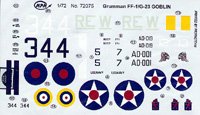 Conclusion
Conclusion
While I don't have the Rareplanes vacuform to compare this kit to, I can say that this one is probably easier to build, and I look forward to the difficulties of figuring out which markings to do it in.
My thanks to MPM for providing the review sample.
 The line of Grumman biplane fighters is a long one, and they have always been a colorful bunch. MPM has come out with the two-seat FF-1 fighter, which was the first of this great lineage. While most people will want this one for the great US Navy color schemes possible, this plane saw service with Canada, Spain and Nicaragua, so there are plenty of interesting choices out there.
The line of Grumman biplane fighters is a long one, and they have always been a colorful bunch. MPM has come out with the two-seat FF-1 fighter, which was the first of this great lineage. While most people will want this one for the great US Navy color schemes possible, this plane saw service with Canada, Spain and Nicaragua, so there are plenty of interesting choices out there.This kit is a multimedia kit, with resin, photoetch and injection parts. This kit also introduces MPM's first attempts at injection molded clear parts, and it's not that bad. While not up to par with such companies as Hasegawa or Monogram, it is definitely usable, and is less work than the vacuform ones in previous kits.
The Kit
 The injection parts are on two trees, and exhibit some very fine molding throughout. There is little flash, and all the panel lines are finely recessed. The wing ribs are well presented, with no fabric texture present and just a hint of the rib, which, with a coat of paint, will look very good. The wing struts are nicely done and are in an airfoil shape. The lack of locating holes will make placement of these struts something of a challenge, but it also eliminates those difficult seams caused by too large mounting pegs. There are separate parts for the G-23 variant which involves cutting a section out of the fuselage and replacing it with another piece. This might turn some off on doing these other variants, but it really doesn't look like it would be much work.
The injection parts are on two trees, and exhibit some very fine molding throughout. There is little flash, and all the panel lines are finely recessed. The wing ribs are well presented, with no fabric texture present and just a hint of the rib, which, with a coat of paint, will look very good. The wing struts are nicely done and are in an airfoil shape. The lack of locating holes will make placement of these struts something of a challenge, but it also eliminates those difficult seams caused by too large mounting pegs. There are separate parts for the G-23 variant which involves cutting a section out of the fuselage and replacing it with another piece. This might turn some off on doing these other variants, but it really doesn't look like it would be much work. The engine is a nicely done resin job, and captures the look of the Wright Cyclone that powers the FF-1. Two choices of cowls wrap around this engine, again as a result of the different variants depicted on the decal sheet.
The engine is a nicely done resin job, and captures the look of the Wright Cyclone that powers the FF-1. Two choices of cowls wrap around this engine, again as a result of the different variants depicted on the decal sheet.The photoetch brass provides a very detailed interior, with a nice relief etched panel, sidewall consoles, and seat belts. Other parts include the wheel box and some mass balances.
 The decal sheet provides choices for no less than four FF-1/G-23s, including one US Navy, one RCAF, and two Spanish ones. The decals are printed by Propagteam and are thin and perfectly registered. There is an error on the sheet, though, in which the serial number for one of the Spanish ones has a nine instead of a three. This is pointed out in the instructions along with a method for fixing it, which is to be commended. This attention to detail and a ready willingness to admit when they have made a mistake is very welcome, and I hope that other manufacturers follow suit. The US Navy version offers two styles of unit badge for VF-5B, letting the modeler decide which way it faces, another nice touch. The Canadian version is a G-23 Goblin of No. 118(F) Sqn, 1941, and the two Spanish examples are from 1a Escuadrillaand 2a Escuadrilla, Spanish Republican Air Force.
The decal sheet provides choices for no less than four FF-1/G-23s, including one US Navy, one RCAF, and two Spanish ones. The decals are printed by Propagteam and are thin and perfectly registered. There is an error on the sheet, though, in which the serial number for one of the Spanish ones has a nine instead of a three. This is pointed out in the instructions along with a method for fixing it, which is to be commended. This attention to detail and a ready willingness to admit when they have made a mistake is very welcome, and I hope that other manufacturers follow suit. The US Navy version offers two styles of unit badge for VF-5B, letting the modeler decide which way it faces, another nice touch. The Canadian version is a G-23 Goblin of No. 118(F) Sqn, 1941, and the two Spanish examples are from 1a Escuadrillaand 2a Escuadrilla, Spanish Republican Air Force. Conclusion
ConclusionWhile I don't have the Rareplanes vacuform to compare this kit to, I can say that this one is probably easier to build, and I look forward to the difficulties of figuring out which markings to do it in.
My thanks to MPM for providing the review sample.
